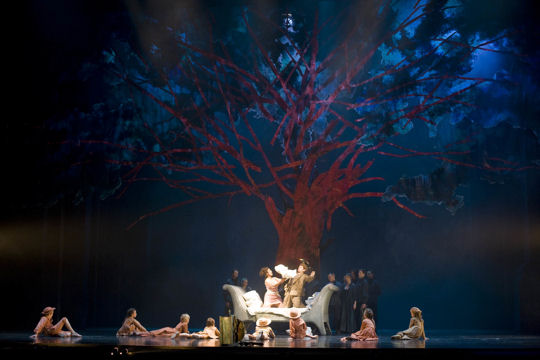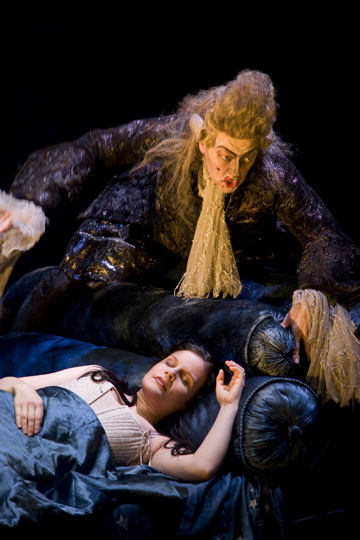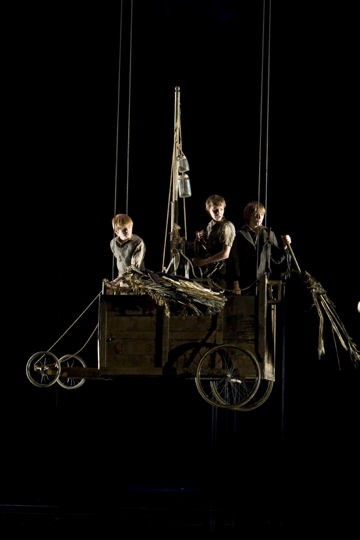Other Links
Editorial Board
- Editor - Bill Kenny
- London Editor-Melanie Eskenazi
- Founder - Len Mullenger
Google Site Search
SEEN
AND HEARD OPERA REVIEW
Mozart Die
Zauberflöte:
Soloists, The Royal Opera Chorus, The Orchestra of the Royal Opera
House, conducted by Roland Böer. Royal Opera House, Covent Garden.
28.1.2008 (JPr)
This 1791 Singspiel ‘The Magic Flute’ in two acts was the
culmination of Mozart’s increasing involvement by the composer
with Emanuel Schikaneder's theatrical troupe that since 1789 had
been the resident company at the Freihaustheater auf der Wieden in
Vienna. Mozart was a close friend of one of the singer-composers
in the troupe, Benedikt Schack (the first Tamino), and had
contributed to the compositions of the troupe, which were often
collaboratively written. A year earlier in 1790 Mozart
participated in Schikaneder’s collaborative opera Der Stein der
Weisen (‘The Philosopher's Stone’), including the duet (‘Nun
liebes Weibchen’
K592a)
and perhaps other passages. Like Zauberflöte, Der Stein
der Weisen was a fairy-tale opera and a sort of precursor
since it employed much the same cast in similar roles. Die
Zauberflöte is noted for its prominent
Masonic
elements; both Schikaneder and Mozart were Masons and lodge
brothers. The opera depicts the triumph of reason over despotism
and is also influenced by Enlightenment philosophy, and can be
regarded as an allegory propounding
enlightened
absolutism. The Queen of the Night is the dangerous
form of obscurantism, whilst her antagonist Sarastro is the
reasonable sovereign who rules with paternalistic wisdom and
enlightened insight. The libretto also contains a racial
stereotype in the form of Monostatos (who makes unwelcome advances
to Pamina mainly because he is a Moor i.e. black) and equally
dreadful misogyny (all women are subservient to men).
Yet lines like ‘Without a man a woman cannot fulfil her destiny’,
‘First duty of Brotherhood is to be aware of the wiles of woman’
and ‘Our sanctuary has been profaned … send these women to hell’
pass the censor untouched. This suggests that misogyny is not as
bad as racism, which is very interesting.
The international cast is solid without being outstanding. I could
be accused of xenophobia of course (to add to Mozart’s racism and
misogyny) but my first Covent Garden Zauberflöte nearly
thirty years ago contained a wealth of home-grown artists such as
Stuart Burrows, Thomas Allen, Kiri Te Kanawa, Robert Lloyd, Donald
McIntyre, Lillian Watson, Paul Crook and Robert Tear in leading
roles, something that sadly it would be impossible to recreate now
for various reasons not to be debated here. The best singing at
the first night was divided between a British baritone, an
Austrian soprano, a Danish bass, a Hungarian soprano and a Sri
Lankan one.

My opinion has always been that these are historical pieces and
are what they are. We do not alter other works of art such as
paintings and some literature if they contain something that
offends our sensibilities today, so why do this to opera? Why not
confront these issues rather than simply expunge all references to
Monostatos’s colour from the work? In David McVicar’s 2003
production (here restaged by Lee Blakeley) he is some periwigged
powdered fop with similarly dressed chorus line cronies - it may
be a funny characterisation but it is light-years from Mozart’s
intentions.

Although this is the third revival of this production, this was
the first time I had seen it. John Macfarlane’s atmospheric sets
are monumental and seem to have been recycled from almost any
Elijah Moshinsky staging of a Verdi opera. Walls scribbled over
with esoteric symbols also appear to have been picked up by Keith
Warner for his Covent Garden Ring. The Three Ladies and the
Queen of the Night are costumed like sci-fi alien creatures which,
I suppose, takes on cues from the libretto. Most of the other
costumes, furniture and scientific apparatus shown would be from
late-eighteenth century Vienna, the time the opera was composed.
To add the fairytale elements there is a wonderfully large serpent
and some splendid animal masks.
Throughout the productions though there is a deliberate lack of
artifice that the Viennese with their fondness for illusion on
stage would not have appreciated. The serpent is manipulated by
the stage crew, as is the bird (which looks suspiciously like a
road-runner) that Papageno attempts to capture on his first entry
to the stage; and things like a glass of wine arise from below
stage in someone’s hand. There is also a movement group used here,
who are not separately acknowledged and who, choreographed by
Leah Hausman, depict both flickering flames in Act II and gently
swaying water both enhanced by Paule Constable’s lighting. The
Three Boys’ da Vinci inspired flying machine has some very visible
‘health and safety’ support.

As Tamino German tenor Christoph Strehl was making his debut with
The Royal Opera. His sound was rather tightly produced and
together with his rather pallid characterisation was not to my
liking, though it did gain more warmth as the evening went on. The
Three Ladies (Anna Leese, Liora Grodnikaite and Gaynor Keeble)
though looking like they were auditioning as Valkyries were
vocally rather indistinct throughout. Thomas Allen, a former
Papageno, was sadly a shadow of his former self and miscast as the
Speaker of the Temple. But John Graham-Hall flounced to good and
seedy effect as Monostatos.
Erika Miklósa was a compelling Queen of the Night hitting her top
Fs with consummate coloratura ease. As Pamina, Genia Kühmeier
projected her role as well as anyone during the evening and sang a
very emotionally affecting ‘Ach, ich
fühl's, es ist verschwunden’. Stephen Milling used his wonderful
bass to cavernous effect as a more-than-usually avuncular
Sarastro, but I thought him a bit too static and that he could
have benefited from more direction. Kishani Jayasinghe, one of
Most of the vocal honours go to Simon Keenlyside’s Papageno. His
interpretation is part Charlie Chaplin in baggy trousers and part
Lee Evans slapstick. Cartwheels, birdsong and a leap onto a
chaise longue are part of his hyperactive performance that
tries, I suspect, to over-compensate for the inertia elsewhere on
stage. Is he the best Papageno I have ever seen? Not quite:
undoubtedly that was Hermann Prey but Keenlyside runs him close
second although I would have liked slightly better use made of the
German words - a problem, it seems, for British singers except
for John Tomlinson of course. Keenlyside’s horrified looks when
Papagena tottered – high on her heels - into view and then
pounced on him were wonders to behold.
The
chorus made their usual incisive contribution and the German
conductor, Roland Böer, conducted a very vibrant and fleet-footed
performance that did not seek any new revelations and if anything
played up the profundity of the work a touch too ponderously. In
conclusion, despite the longueurs of the spoken German
dialogue not really attacked with any great enthusiasm by the
polyglot cast, except perhaps Harry Nicoll as First Priest, the
performance went by quickly and enjoyably. Too few nights at the
opera are like that.
Jim
Pritchard
Pictures © Bill Cooper
Back
to Top
Cumulative Index Page
